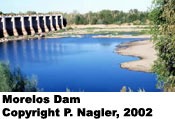
community | data | history | publication list | partners | site map
Events
International Conference of GIS and Remote Sensing in Hydrology, Water Resources and Environment, to be held in Three Gorges Dam site, September 16-19, 2003.
News
A group of Mexican and UA researchers has surveyed an important wetland area served by seepage by the All American Canal. We have submitted an article on these wetlands, but thought we would bring them to your attention as they may disappear soon due to the proposed lining of the canal.
The Colorado River meanders through a 140-km passage from the US-Mexico border through the heart of the Sonoran Desert on it's way to the sea. This delta region of the river receives less rainfall than any other location in North America but is nonetheless an oasis when the river flows. Recently there has been a renewed interest in the delta due to water releases from the U.S. to Mexico. Following construction of Hoover Dam (1935) and Glen Canyon Dam (1964), little or no water flowed to the Gulf of California. Lake Powell, the last reservoir built on the river, finally filled in 1981, and since then occassional flood flows have resumed. During years of excess precipitation in the watershed, as during the El Niño cycles of 1983-86, 1993, 1997-99, water is spilled from the dam system to the sea, revitalizing the delta habitats along the way.
It is this unique interplay of water, sediment, and vegetation, both prehistoric and contemporary, unregulated for the majority of it's existence and modified in striking ways during the last century, that lures geographers, hydrologists, and biologists to this incredible living laboratory. More... |
 Augmenting
these flood flows, the US has discharged appreciable quantities
of agriculture return flows into the southeastern part of the Delta
since 1977, creating a large, brackish marsh (Cienega de Santa Clara).
Local agricultural return flows in Mexico have created smaller wetlands
in the Delta.
Augmenting
these flood flows, the US has discharged appreciable quantities
of agriculture return flows into the southeastern part of the Delta
since 1977, creating a large, brackish marsh (Cienega de Santa Clara).
Local agricultural return flows in Mexico have created smaller wetlands
in the Delta.
